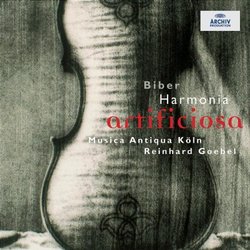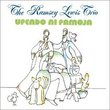| All Artists: Heinrich Ignaz Franz von Biber, Reinhard Goebel, Musica Antiqua Köln, Léon Berben Title: Biber: Harmonia artificiosa Members Wishing: 0 Total Copies: 0 Label: Archiv Produktion Release Date: 5/11/2004 Genre: Classical Styles: Chamber Music, Forms & Genres, Concertos, Historical Periods, Baroque (c.1600-1750), Classical (c.1770-1830) Number of Discs: 2 SwapaCD Credits: 2 UPCs: 028947496526, 028947496526 |
Search - Heinrich Ignaz Franz von Biber, Reinhard Goebel, Musica Antiqua Köln :: Biber: Harmonia artificiosa
 | Heinrich Ignaz Franz von Biber, Reinhard Goebel, Musica Antiqua Köln Biber: Harmonia artificiosa Genre: Classical No Description Available. Genre: Classical Music Media Format: Compact Disk Rating: Release Date: 11-MAY-2004 |
Larger Image |
CD DetailsSynopsis
Product Description No Description Available. Genre: Classical Music Media Format: Compact Disk Rating: Release Date: 11-MAY-2004 Similar CDs
|
CD ReviewsMore outstanding Biber from Goebel & MAK Ruminator | The Fencepost | 03/01/2006 (5 out of 5 stars) "Reinhard Goebel and his ensemble, Musica Antiqua Koln, have been pioneer advocates for Biber's music for almost 20 years. MAK's recording of Mensa Sonora set high standards for this composer at a time when few ensembles would take the risk. Now, widely accepted as important to the baroque repertory as Corelli, taken up by a range of esteemed performers such as John Holloway and Andrew Manze, Biber is commonly represented in the CD catalog and heard often on classical radio. And all for good reason. Biber was known as an outstanding violinist and his compositions are clearly designed for exhibition and entertainment. His intrumental work compares favorably to any composer of his generation, perhaps excepting Buxtehude, whose teaching was the object of a legendary 200-mile foot-journey to Lubeck by nobody but the great JS Bach himself. Both composers deployed multi-sectional structures with dramatic alternations of mood and tempo that enhance the expressive and virtuosic qualities of their music. Sometimes known as Stylus Phantasticus, adopted also by Schmelzer, Mattheis and others, this approach can be less restrictive than the formal developments of Corelli. Biber also distinguished his music with adventurous harmony, as in the Battaglia and Sonata Representiva, and by the method of scordatura, or alternate string tunings. In his notes Maestro Goebel informs us that he has "brooded" on this collection since his youth, and offers this recording in honor of the tercentenary of Biber's death and the 30th anniversary of MAK's founding. I mention this only to add that, after his last Biber recording in 1990 of the Mystery Sonatas, Goebel was struck by a freak paralysis that forced him to re-learn his instrument left-handed so he could continue to perform as MAK's Konzertmeister. So how lucky can we be? Readers probably know that MAK's Harmonia Artificiosa isn't a premier recording - while Goebel brooded and broke paths to Heinechen and Veracini, the Purcell Quartet, Tafelmusik, and the Rare Fruits Council all got here first, and the latter account with Manfredo Kraemer raises very high standards while fitting all 7 partitas on 1 CD. So one may reasonably wonder whether or not this new contender is justified or competitive. Pricewise there is no issue; Goebel's 2 CDs are offered for the price of one. Dividing the set allows the listener to consume it in smaller servings, while MAK's tempos needn't be rushed by time constraints. Of course these are also virtues of the Purcell Quartet's 2 CD set, but as much as I enjoy Elizabeth Wallfisch, the PQ don't have the transparency or precision that characterizes the MAK recording, and Chandos isn't as generous with pricing. Though one can now obtain the RFC version as a budget 2-fer with their Sonatae Tam Aris, the companion set is lightweight fluff compared to the Harmonia Artificiosa. Finally, I have not heard the Tafelmusik version, but I have generally found their recordings to be on the bland side. Lest anyone think I'm blindly dazzled by this CD, let me say that it exhibits everything we expect from composer and performer, warts included. Like most of his peers, Biber often shifts tempo with rapid runs and scales that sometimes sound like no more than advanced music lessons, but such passages are more common in his solo sonatas, as Biber applies an expert craftmanship to balancing both treble voices of these trio partitas for more expressive results. In other words, this set represents Biber's instrumental composition skills at its finest, matching the accomplishments of his Mensa Sonora and Fidicinum Sacro-Profanum. Listeners already familiar with MAK will not be surprised by the occasional extremes this group takes to distinguish itself from the mundane - such as accelerated allegros or accentuated beats. I personally don't find these to be troublesome when they are accompanied by so many other redeeming qualities. The sound image is very clear and revealing in a way that might be too close for comfort for many ensembles, but here it actually seems to highlight the collective virtuosity that MAK is well known for. And unlike other versions, MAK seems to give less preferential treatment to specific partitas, discovering more delights throughout the entire collection. Have I said enough? I conclude with the hope that Maestro Goebel has also been brooding on the fabulous Fidicinum Sacro-Profanum, and that he will fill a gap in this rarely recorded repertory before another 30 years pass by. Thanks for reading my review. PS: While my hopes for a Goebel recording of the Fidicinum Sacro-Profanum still remain in vain, I have since discovered a worthy alternative from David Plantier and Les Plaisers du Parnasse, on the ZigZag label Biber: Fidicinium Sacro Profanum that I find quite satisfactory on its own terms." Second best Holofernes | Brookline, MA, USA | 01/31/2006 (4 out of 5 stars) "Once you've heard the version by Tafelmusik (Sony, currently unavailable in the U.S., though some copies are selling on amazon's U.K. site), this one by Goebel & Co pales in comparison. Having developed great familiarity with many of M.A.K.'s recordings over the years, this was a shock to me. Compared to Tefelmusik's spritely Presto movements, M.A.K.'s jog along relatively sedately. The crux of any performances of these works is Partita VII, especially its final (seventh) movement, the sublime Arietta variata. In the short keyboard introduction to the movement, Goebel's harpsichordist's phrasing is pedestrian compared to Nedinger on Sony. Tafelmusik's rendering is an integrated whole, M.A.K.'s is choppy; it also takes a full minute longer, whereas the piece demands the greater pace supplied by Tafelmusik. Not everything favors the Canadian group, however; the tonal variety of M.A.K. is superior in the penultimate Trezza movement. And the sound and overall balance of the recording is close to perfection. But on balance, it's no contest; go with Tafelmusik (which also sounds fine), if you can find it." A Fiddler's Dream Giordano Bruno | Wherever I am, I am. | 10/03/2007 (5 out of 5 stars) "Biber was in a sense the Paganini of his time, the fiddler whose virtuosity seemed almost like a Faustian bargain, and the bulk of his music was written for violinists of diabolical skill. Expect fireworks, eccentricity, and artifice in any consort music by Biber. This performance of Harmonia artificiosa is a prime example, and this sort of music is exactly fitted to the skills and temperament of Reinhard Goebel, who has now recovered most of his astonishing virtuosity after a hideous bowing-arm problem that almost finished his playing career.
Goebel writes in his notes: "I have brooded on these partitas for thirty long years, weighing them up in my mind..." The conclusion he has reached seems to be that the seven duet suites of Biber's 'Harmonia artificioso-ariosa' are among the culminating works of Baroque chamber music, and Goebel has made this recording perhaps the crowning effort of his career with Musica Antiqua Koeln. There's only room in our Pantheon for one God of Baroque, I suppose, and that would be Bach. But Biber ranks well up with the best of the rest, with Schuetz and A Scarlatti and Handel. Goebel's interpretation of the Seventh Partita, for two violas d'amore, offers a special opportunity to compare two fabulous performances, his and Marianne Ronez with Ensemble Affetti Musicali on their CD 'Viola d'amore', which I have also reviewed glowingly. The first difference a listener will hear is of the continuo. Ronez uses viola da gamba, theorbo, and harpsichord, a big booming continuo which partners more than complements the two violas. Goebel regards doubling the continuo as inauthentic; he uses only harpsichord and cello, with a more transparent realization throughout. Tempi are also different; Goebel tends to leap from slow to fast as if crying 'hold your seatbelts'. The times of the recording are misleading, however, since Goebel also doggedly plays every repeat, including triple repeats on the shortest sections. I like both performances very much... very much indeed... but I have to give the palm to Goebel for polished perfection. I also think he's right in this case about the continuo. Like Bach at the end of his career, Biber seems in these seven partitas to be taking a stand in defense of his own musical values in the face of the superceding popularity of the galante French and Italian styles of trio sonatas, less moody, less harmonically complex, easier on the minds of superficial listeners. Thus he packs each partita with affect and effect, and with a lot of surprises, including the use of violini piccoli and of violins in difficult scordatura double-stop passagework. No modern violinist could perform these works at all; the metal strings on a 20th C violin would snap or sag. All in all, if you're any kind of Baroque music lover, you really must have this performance in your collection. And if you can find a way to buy options on Biber's stock in the musical market, tell me how!" |

